Some of the greatest ideas never get fleshed out and remain… great ideas.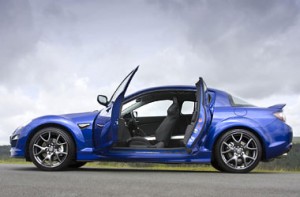
Mazda’s rotary engine, for instance. And the car that was built around it.
The RX8.
Well, it began with the RX-7 – which first came to market in 1978. It was the heir-apparent of the Japanese (home market) 1967-’72 Cosmo – Mazda’s first production car foray into rotary engine technology.
All three were gorgeous cars; great sports cars. Quick – nimble. Technologically advanced.
And yet, they failed, each in turn.
A triple flop.
Why?
The very thing that defined them, ultimately killed them.
The rotary engine – also known as the Wankel engine, after its inventor, Felix Wankel.
Like perpetual motion and zero point energy, this unusual engine design has been tantalizing car companies for decades.
And disappointing them for just as long.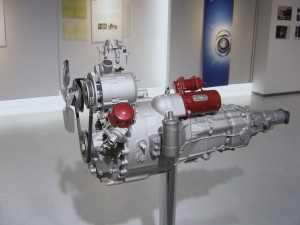
It all began in the the mid-1960s, when Mazda saw what it believed to be the future – and it was piston-less. The Japanese automaker was one of several that rushed to sign licensing agreements with NSU Motorenwerek AG, the German firm that had been developing Wankel’s idea. General Motors, AMC (the Pacer was designed around the rotary engine concept) even Suzuki (for motorcycles) bought in, too.
It is not hard to understand why.
The engine was a truly revolutionary design – one that promised more hp and less weight from a smaller, theoretically more efficient engine.
This was achieved – well, promised – by eliminating the conventional reciprocating engine’s heavy block, with individual cylinders bored to house pistons that moved up and down in syncopation with the explosive force of internal combustion, their vertical motion translated (after efficiency losses) into rotational motion via a longitudinally mounted crankshaft. Which had to endure tremendous forces as each piston exerted downward pressure and was then – in an instant – pushed back up again. Times however many cylinders the engine had. This arrangement also tended to induce vibration – which had to be tamped down by counterweights and balancers. Which made the engine heavy as well as complex.
Wankel’s original design was ingenious. 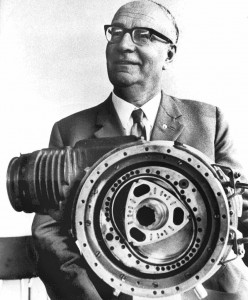
Instead of pistons going up and down, a kind of rounded-at-the-tips three-sided triangular rotor spins inside the crankcase, the space between each tip serving as the combustion chamber. As the rotor turns, ports are uncovered – admitting air (and fuel) and allowing exhaust gasses to escape. No energy is lost in (up and down) translation. There are no connecting rods, no conventional valvetrain.
And virtually no vibration – without any need for counterbalancing.
By getting rid of all those parts, one got rid of a lot of beef. This matters to car designers – especially sports cars designers. The original ’67 Cosmo’s engine weighed about as much as one large man (225 pounds) and two reasonably strong men could pull one out of the car (and re-install it) by hand.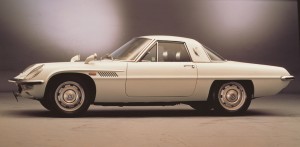
The reduction in rotating mass (and stresses) also allowed very high engine speeds – 7,000 RPM for the first generation and close to 10,000 RPM by the time of the RX8. Very few piston engines are capable of reliable – and sustained – operation at such speeds. This was just the ticket for a high-performance sports car, where a revvy engine is much desired.
As is a compact engine.
The rotary engine’s high specific output was (still is) achieved without a comparable increase in displacement. The original Cosmo’s engine was smaller than many current motorcycle engines – just 982 cubic centimeters (less than 1 liter) for the original Cosmo’s Series I rotary powerplant. Yet it produced a very respectable 110-130 hp. For some perspective, the Chevy Corvair – which was being sold around the same time as the Cosmo – had a six cylinder engine more than twice the size that made about the same power (90-110 hp).
By the time of the 1990s-era RX7, the rotary engine was making nearly 300 hp (when turbocharged) out of 1.3 liters.
This is one of the highest output-per-liter-of-displacement ever achieved.
Mazda dialed back the power some when the RX8 replaced the RX7 in 2001- but the 1.3 engine was still producing 232 hp when ordered with the six-speed manual transmission.
But, there was a hair in the soup.
Three, actually.
First, the rotary engine was – and still is – shockingly thirsty for a such a small engine. By 2011 – the final year for the RX8 – the window sticker read 16 city, 23 highway. Many V8s three times the size use less fuel. And most motorcycle piston engines of about the same size deliver twice the fuel-efficiency.
By itself, this probably would not have been a deal-breaker. Fuel economy is a big consideration for economy car buyers, but sports car buyers are usually willing to overlook a rapidly draining tank if the car delivers the goods. Which the RX8 absolutely did. It was quicker (and faster) than Mazda’s other sports car – the hugely popular but somewhat slow-pokey Miata. And it handled better than the Miata, because of the rotary engine’s behind-the-front-axle location – which conferred closer to the sports car ideal 50-50 weight balance.
That plus a sport bike engine’s capability to rev close to five figures endeared the car to enthusiast buyers.
But the car’s hungry hippo appetite was a problem for Mazda – because of federal fleet fuel economy mandates (CAFE, in the vernacular of regulatory officialdom). Each 18 MPG (average) RX8 that got built lowered Mazda’s fleet average fuel economy numbers – which incurred gas guzzler fines if the number dipped below the then-in-effect 27.5 MPG average decreed for passenger cars. With a 35.5 MPG – average, remember – mandatory minimum on deck for model year 2016, the RX8’s appetite was as much in the spotlight as Caitlin Jenner is right now. And the dilemma for Mazda was that in order to increase the rotary engine’s fuel-economy, it would be necessary to make changes to the rotary engine’s design that would likely increase its emissions of politically incorrect gasses.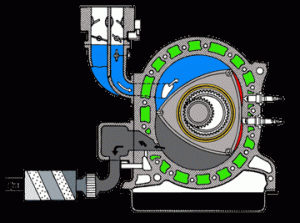
Sealing problems had long been – and continue to be – the rotary engine’s Achilles Heel. Piston engines use multiple expanding rings around each piston to maintain compression and prevent oil from getting into the combustion chamber, where it would otherwise be burned along with the incoming air-fuel charge and then sent hence via the tailpipes to the surrounding air. Also, there are tulip valves (with seals) that control the flow of intake and exhaust charges – vs. the fixed-in-place ports that are covered and uncovered as the rotor spins.
The rotary engine depended on seals at the tips (apex) of each rotor to contain combustion gasses but these seals were prone to leak as well as to leak sooner rather than later, especially under hard use. The ports were also an issue, emissions-wise as there tended be overlap between cycles and some of the “bad” gasses – especially unburned hydrocarbons – tended to escape into the atmosphere.
It was not a big deal initially.
When the Cosmo came out in the late ’60s, blue smoke was as common a sight as bell-bottomed hippies in San Francisco. It was legal to sell engines that burned oil on purpose (the famous two-stroke sport bikes of the late ’60s and early ’70s) and in general the public didn’t give a damn. So long as the thing ran like stink it was ok if it actually did stink.
Then came the Environmental Protection Agency (EPA), presidential penned into existence by Richard Nixon and along with it, the Clean Air Act of 1970.
These two developments would prove to be the death warrant of the rotary engine as a passenger car powerplant – and by dint of that, The End for Mazda’s rotary-engined sports car.
And not just Mazda’s rotary-engined sports car. Also GM’s (intended-to-be) rotary-engined economy car, the Chevy Vega. It, too, was originally designed around the rotary concept. But when GM engineers were unable to get the NSU-licensed mill passed the EPA’s smog gantlet, a conventional piston-engined replacement took its place.
The same fate befell the (also-planned) rotary-engined AMC Pacer, which likewise ended up being sold with an overly heavy and underpowered but smog-approved piston engine instead. LIke GM, AMC had poured millions – in 1970s money – into the rotary engine and spent years trying to make it pay off.
It never did.
There were other victims, too. Suzuki had planned a whole line of motorcycles built around the rotary engine and even built (and sold) a few. But the whole thing had to be kiboshed and – to this day – motorcycles (not just Suzukis) continue to be powered by conventional (piston) engines.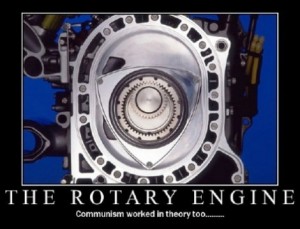
Mazda hung in there for a long time – and managed to keep the rotary engine within plausible EPA spec all the way through 2011, in part by relocating the exhaust ports. But the changes Mazda made to the engine killed the engine’s fuel economy, leading to a Catch 22 scenario. The engine could either be reasonably fuel-sippy and and “dirty” (as defined by EPA’s increasingly unreasonable standards) or it could be “clean” (by the early 2000s, fractional reduction in exhaust emissions separated “dirty” vs. “clean” engines) and thirsty.
Either way, Mazda was screwed. 
The cost to keep the rotary smog legal was also high – and this rendered the RX8 an increasingly pricey car. The final year – 2011 – the car’s bas price was $26,680.
Meanwhile, the Miata cost thousands less – and it handled nearly as well. It got much better gas mileage, didn’t annoy the EPA and had a well-earned reputation for being all-but-indestructible. Miatas could – and still do – run on the track every weekend, then drive their owners to work every week…. for 200,000 miles. It has been – cue Borat – a great success for Mazda.
While it is common to see 20-year-old Miatas still in daily driver service, it is rare to see an RX8 on the road at all. A few still survive, tucked under covers safely in enthusiasts’ garages – beautiful reminders of a great idea that never quite panned out.
RX8 Trivia:
* In addition to its unique rotary engine, the RX8 also had an unusual (for a sports car) four-door body design. An extra set of rear-hinged (“suicide”) doors that greatly improved access to the small but now-usable rear seats. While the RX8 may have consumed more gas than V6 and even V8 powered 2-plus-2 sport coupes like the Chevy Camaro and Ford Mustang, it could at least carry more than two people. The GM and Ford ponycars were (and still are) infamous for their vestigial and essentially useless back seats. The RX8 might not have gone as far on a tankful, but you could take more people with you, however far you did go.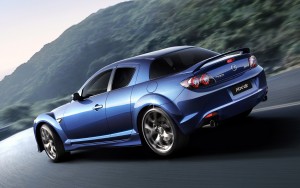
* Beware the automatic-equipped versions of the RX8. The engine is detuned to 197 hp and torque – of which there is not much available – is virtually nonexistent until the engine is spinning over 5,000 RPM. The result is a bad case of The Slows. At least with the manual, you can rev the 1.3 liter engine up to the point in the powerband where it begins to make power (and torque). But with an automatic all you can do is floor the gas and … wait. Meanwhile, gas mileage with the automatic is even worse than with the six-speed stick. These cars were epic pigs, typically delivering about 16 MPG on average. Many V8 muscle cars from the ’70s did about the same – and they at least had torque in abundance and worked great with automatic transmissions. 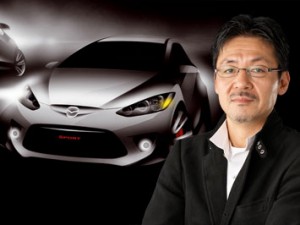
* To emphasize the rotary engined-heart of the RX8, triangular design motifs were used for the headrests and other shapes within the car and outside, too. Lead exterior designer was Ikuo Maeda – the son of Matasaburo Maeda, who had been the lead designer of the RX7.
* The RX8’s “front mid-engine” layout and near 50-50 weight distribution gave the car what engineers call a low polar moment of inertia – in plain language, its resistance to turning. The RX8 turns more eagerly, with less input, than most front-engined cars.
It is also a very neutral-handling car, tending to neither over or understeer.
* The ax first fell on the RX8 in the export/European market after the car was unable to meet the latest EU emissions standards. Mazda had to stop selling the car in Europe after the 2010 model year. The loss of that market – along with anticipated problems keeping the car compliant with U.S. emissions standards – resulted in Mazda’s decision to pull the plug for good after the 2011 model year.
Excerpted from the forthcoming book, Doomed.
Copyright 2015, Eric Peters
If you value independent media, please support independent media. We depend on you to keep the wheels turning! And the Clovers carpet-chewing!
Our donate button is here.
If you prefer to avoid PayPal, our mailing address is:
EPautos
721 Hummingbird Lane SE
Copper Hill, VA 24079
PS: EPautos stickers are free to those who sign up for a $5 or more monthly recurring donation to support EPautos, or for a one-time donation of $10 or more. (Please be sure to tell us you want a sticker – and also, provide an address, so we know where to mail the thing!)




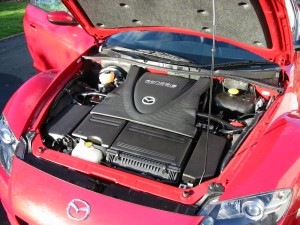
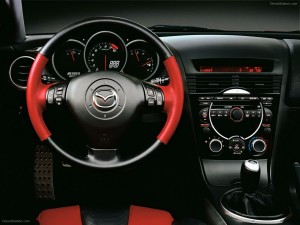






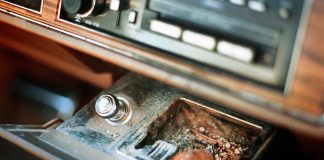
I looked at an ’85 RX-7 some years ago. It was fast; what a BALLSY little car! I didn’t care for the clutch pedal though; it was awkwardly placed, making it hard to use. I didn’t buy that car.
Chevy loved the rotary engine so much, that even after abandoning it as the powerplant for their Vega, they still managed to use a conventional piston engine, which like the rotary, would grenade at about 30K miles…..
“Like a rock”! (Yeah! You’ll find Chevys and rocks on the bottom of the ocean!)
Nunzio,
You mean to tell me that Chevy isn’t built Ford Tough?
I fell for the RX-7, finally got a chance to own one a few years back; they are THIRSTY. 9mpg real world fuel economy. It loves FUEL and RPMs; all of the power lived at high RPMs.
Hi Alex,
Yup!
I got to drive several when they were new. Very fun – but very thirsty. Shockingly so, for such a small (and small-engined) car.
But that would not necessarily deter me from owning one!
I remember building a model of a “visible” Wankel engine with my dad. Not really sure why we got rotary instead of the V8, maybe dad just picked up the wrong one. I didn’t really understand how it could work at the time (but I did understand 2 and 4 cycle pistons), but it was pretty neat watching it all work.
Here it is: http://www.ebay.com/itm/Revell-Visible-Rotary-Engine-Operating-Model-1-3-Actual-Size-No-H913-/181768044638
I think people get a bit confused regarding the displacement of a Wankel engine. While it’s rated at 1.3 liters, a Wankel differs significantly from a 4 stroke piston engine (requiring two crank shaft revolutions to generate each power stroke per piston). It’s not really a fair comparison as the Wankel operates more like a 2 stroke engine requiring only one crank shaft revolution per power “stroke.” I would liken it to a 2.6 liter 4 cylinder engine.
Here’s a good visual: https://www.youtube.com/watch?t=25&v=OuId4nuxXaM
As far as them being low torque, this is not a surprise as they are similar to oversquare, short stroke piston engines that can rev very high, but which suffer from low torque (think 4 cyl motorcycle engines). The power phase of a Wankel is indeed a very short “stroke.”
The Wankel is an amazing engine. The twin turbo 3 rotor that came in the Japan only Cosmos gets about the same fuel economy as a carbureted Big Block Chevy.
With a upgraded turbo, those motors are absolute animals.
About 20 or so years ago, GM tried turning a SBC into a two cycle. In de-tuned form it made nearly twice the power of the four cycle. The fly in the ointment though was the same one all manufacturers face, the infamous “cold start up emissions”. They evidently devoted almost all their resources in developing this engine just to meet that criteria. They just couldn’t do it for obvious reasons we now have “California Compliant” lawn mowers and other small engines. As a young man I thought i might get to see a time when Ca. would really fall off the continent but alas, it hasn’t come to pass. So many clueless fools and politicians and bureaucrats with no conception of actually creating something.
I’m a huge fan (as regulars here know) of the two-stroke engine. The power delivery is like nothing else.
The sound, too!
My boss has a Wankel powered chain saw that he brought back from Germany in the 60s. No worries about ’emissions’ there, and little about ‘mpg.’
Bought a ’74 RX-4 Coupe in 1975, and that rotary rocked my world!
With a 70’s best available 4 speed stick, it wasn’t that slow off the line. Then it could rev higher and higher….accelerating all the way.
Too bad about the emissions and economy engineering challenges. Imagine a rotary RX-9 with 350 horsepower, and even 225 ft lbs of torque. I’d rather drive that than any Corvette ever.
Todays car buyers seem preoccupied with torque. You’re leading the charge with your diesel love. And there’s definitely nothing wrong with either torque, or high diesel mpg.
But at one time, there was something that was very interesting and different. And it was more euphoric than anything short of a Ferrarri.
Mike, I like em all. I love the high revving small engines and the big torque monsters. I don’t see me living to see one that will do it all. But I recall when they raced a 4 rotor Wankel that did good but had reliability problems. And I recall when Audi was handing everyone their butts with their turbo-diesels too.
I didn’t have a license when the Porsche 911 was introduced but I wanted one bad(I was driving that pickup as if it were one). No telling how many articles I showed my dad and all the reasons he should buy one. He was such a good guy he didn’t just laugh in my face. I think he thought my hunger was a good thing and would drive me to buy one someday. I recall some of my parents old friends came to visit and he and my dad were outside when I made my landing. I got out and Uncle Johnny said to my dad(and me) “I didn’t know a Chevy pickup was a sports car till now”. He and my dad laughed and I grinned. I had a spinner on the steering wheel and could cut a corner like Jim Hall.
To be honest, he did look at it hard and probably wished he could buy one we could both give hell. And he knew dreams were best served as reality and would have bought me one if he’d had that kind of money even with my mother screaming to the almighty I’d kill myself.
I always thought riding a bike and driving a hot car(or a car you just drive on the edge….hot or not) kept you up on your game and still do. I’ve spent the last two days hauling rock down tiny, twisty roads and it’s kept me up on my driving game anyway. No worry about going to sleep when you’re constantly shifting and braking and giving that 60 Series Detroit hell. I’m damned tired of hearing that Jake Brake though.
just remember, torque and horsepower are not independent numbers. At any given rpm more torque equals more hp (and vice versa).
How do you get 900 hp from 3.0L naturally aspirated? You spin it to 15k+ rpms…..
I remember reading about the Wankel engine many years ago.
Excellent power plant except for the relatively poor fuel economy and tendency to burn oil.
Drove my relative’s Mazda (R-100 or RX-2 I think) little sedan box 300 miles along the interstate to go camping in 1975. Different kind of experience then the normal rice boxes at the time. Would do 90+ all the way, hills, valleys and all without any problem. Just sucky gas mileage. But zero engine vibration and lots of useable power from idle to max. It also made me think the engine died at every red light.